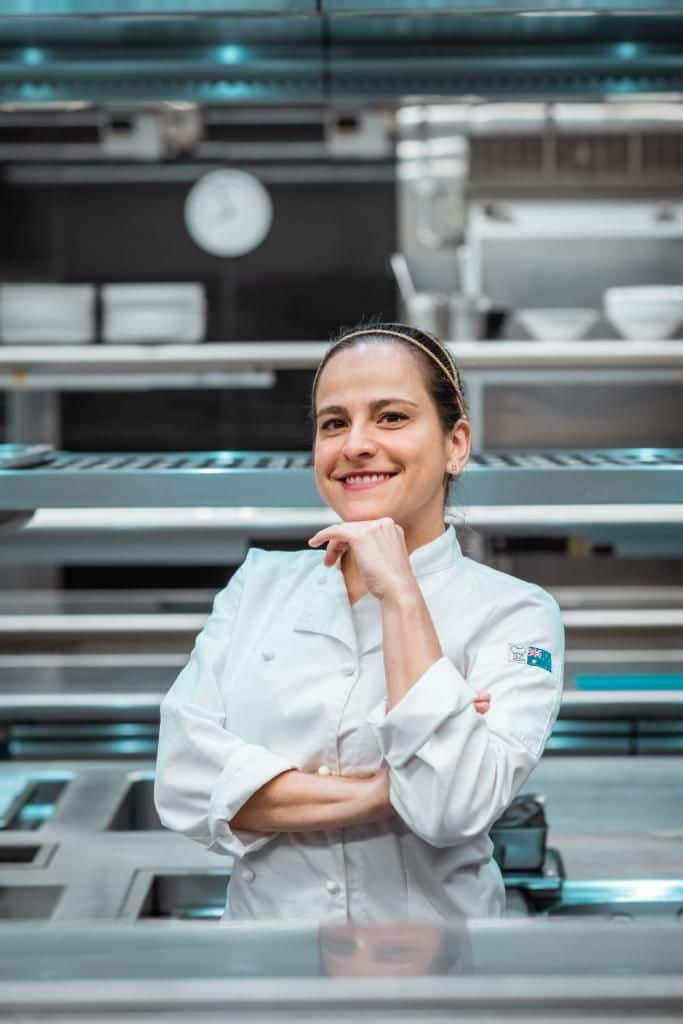Gastronomy is not only one of the most chosen professions by Brazilian migrants but also a field in which they have proved highly successful.
They are known for being fast, skilful, lively and moving quickly in Australia’s multicultural gastronomic universes.
The Brazilian consulate in Sydney invites Brazilian cooks who work in renowned Australian restaurants to post on its Instagram profile a recipe that either reminds them of Brazil or ties up their learnings in Australia with Brazilian cultural heritage.
In its second edition, this project brings recipes from chefs Bruno Cestari, Gabriela Macedo, Silvia de Moraes, João Philot, Rachel Belle and Geysa Monteiro.
In an interview with SBS Portuguese, they compare and contrast the culinary legacy of their home country and their adopted home.
Barbeque without charcoal? No, thanks!
Bruno Cestari says he understands the art of barbeque.
He spent a part of his childhood at his grandfather’s butcher shop, who deboned carcasses with Bruno’s uncles, while his mother took care of the cash register. His passion for meat was born there and it followed him to Australia, where he rediscovered himself in professional kitchens.
Today, in addition to being the general manager of operations for the Boathouse Group in Sydney, Bruno is part of a team of American-style barbeque chefs that compete in Australia and the US.
But being a barbeque expert wasn’t enough for him to grow professionally in Australia.

Bruno Cestari works for the Boathouse Group in Sydney.
"I had to learn about fish, shells, shrimp, oysters, lobster – things I didn’t have access to in Brazil,” he tells SBS Portuguese.
Barbeque is a much-loved cooking technique in both Australia and Brazil. Bruno explains the difference between the method in both countries.
Gas barbeque is not barbeque in my country. In the south of Brazil, it is impossible to do it using an electric or gas grill.Bruno Cestari, Brazilian chef in Sydney.
“The number of cuts used in Brazil is much higher than in any other country. We barbeque prime cuts like sirloin steak (the so-called Brazilian ‘picanha’ and ‘contra-filé’), but we also do wonders with cuts like the Brazilian cupim and bone marrow.
“Each cut has its special seasoning, temperature and cooking time. Here in Australia, I see barbeque restricted to five or six types of beef cuts. And something similar for carcasses of pig and sheep,” he elaborates.
Love for leftovers
Geysa Monteiro was born in Porto Alegre in the south of Brazil, a land known for its passion for barbeque. She is currently a chef at RACV Noosa Resort in Queensland.
For her, barbeque is an emotional, family-binding tradition that combines the love for her state in Brazil (Rio Grande do Sul) with Queensland, where it is also very popular.
Geysa chose a ‘carreteiro’ (bullock cart driver in Portuguese) rice recipe made with barbeque leftovers.
The dish gets its name from the men who transported products in bullock carts in the olden days. They had a recipe that called for cooking barbeque meat leftovers in a pan with rice.
There is an emotional element in the choice of this particular dish as well as in the use of what is left over.Geysa Monteiro, Brazilian chef in Sunshine Coast.
“Overall, the ‘carreteiro’ is delicious and has similar versions in other countries. It is easy for different people to associate with its flavour,” she adds.
Amazon to Darling
When she migrated to Australia, Rachel Belle only knew how to prepare instant noodles.
Today, she is a chef at the Michelin-starred Tetsuya’s in Sydney, which offers a menu inspired by Australian, Japanese and classic French cuisine.
It wasn’t easy for a journalist who barely knew how to fry an egg, to become a chef in a country whose language she was still learning.
One of the biggest lessons for Rachel was continuously learning to manage the fear of the unknown and to control her emotions so as not to give up halfway through.

Rachel Belle, Brazilian chef in Sydney.
Brazil's biodiversity of freshwater fish is amongst the largest in the world.
“The variety of fish is huge in Brazil and Australia, with flavours typical of the waters they come from. The big attraction, in my opinion, is our freshwater fish, especially those from the Amazon region, such as Tambaqui, Tucunaré and Pirarucu – which is considered the largest freshwater fish in the world," she tells SBS Portuguese.

Silvia de Moraes, Brazilian chef in Sydney, and her moqueca.
Silvia de Moraes is a chef at Manly Pavillion in Sydney. She chose the Brazilian dish moqueca and its regional versions for this project.
“Moqueca is very similar to Asian cuisines and is like a fish stew — everything cooked in a broth and curry. Coconut milk is now trendy in Brazil. This dish is accessible, tasty and a symbol of Brazil.
“I gave it an Australian touch by using fish stock and chilli while retaining its Brazilian character with palm oil – essential to Brazilian cooking,” she tells SBS Portuguese.
Seasonality: A lesson learned in Australia
João Guilherme Philot was a chef in Brazil too before continuing to be one in Australia.
He works at Hero, the restaurant at the Australian Centre for the Moving Image in Melbourne.
Explaining the differences between Australian and Brazilian gastronomical techniques, he says the seasonality of ingredients is highly respected in Australia, which is great for cooks.

João Guilherme Philot, Brazilian chef in Melbourne.
We can extract the best flavour and, at the same time, care for the environment.João Guilherme Philot
With this awareness, I started to value each ingredient in a dish’s composition even more,” he tells SBS Portuguese.
João took inspiration from the rural life of his family from the hinterland of Rio de Janeiro state to prepare a canjiquinha, which is cracked corn (in between polenta and risotto) with pork belly, guava gravy and crispy kale.

Canjiquinha with pork belly, guava gravy and crispy kale.
Gabriela Macedo is a chef at the Institute Polaire in Hobart.
Her entry for the Brazilian consulate’s project was the very Brazilian honey cake, which is a delicacy eaten at any time, regardless of it being a dessert. Gabriela uses local ingredients such as Tasmania’s renowned honey.
For her, the relationship with sugar is different for Brazilians and Australians.
“This is something that intrigued me as soon as I arrived here, starting with our Brazilian coffee, which, in addition to being brewed, is often served already sweetened with white sugar. In Australia, it is customary to serve it with raw sugar, if at all,” she says.
I reduced the amount of sugar a lot to please the Australian palate.Gabriela Monteiro, Brazilian chef in Hobart.
Gabriela says that the amount of sugar she uses in her recipes defines the chef that she is.
“We have some Brazilian desserts that I have included in the restaurant’s menu, such as pudding and lemon pie," she adds.
“I think restaurants and chefs have a crucial role in adjusting ingredients to suit different cultures without taking away the originality of a dish,” she tells SBS Portuguese.
And for that reason, I am very passionate about Australia’s mix of cultures and flavours.Gabriela Macedo
"For some of the Brazilian desserts that I already included in the restaurant's menu, such as pudding and lemon pie, I reduced the amount of sugar a lot to please the Australian palate.
"I think restaurants and chefs have a crucial role in adjusting ingredients to suit different cultures without taking away the originality of a dish.

Gabi Macedo, chef no Institut Polaire, em Hobart.

Brazilian honey cake made by Brazilian chef Gabriela Macedo.
INGREDIENTS
Cake:
3 eggs
½ cup brown sugar
1 tablespoon unsalted butter
100ml full cream milk
1 ½ cup plain flour
1 tablespoon cinnamon powder
Pinch ground nutmeg
1 teaspoon ginger grounded
1 teaspoon cloves grounded
100g honey
1 tablespoon cocoa powder
1 tablespoon baking powder
1 teaspoon soda bicarbonate
Filling:
1 can dulce de leche or caramel filling
Ganache:
300g dark chocolate buttons
150ml pure cream (35% fat)
INSTRUCTIONS
· Use a mixer to beat the eggs with brown sugar until it is completely dissolved. Add honey, cocoa powder and spices, and mix it at the lowest speed.
· Slowly add milk and flour until the mixture looks smooth. Add the baking powder and soda bicarbonate and quickly mix until all ingredients are fully incorporated.
· Spread the mixture in a greased baking pan and bake it at 180 degrees for about 35 minutes. Remove it from the oven and let it cool to room temperature.
· De-mould the cake and cut it into two halves. Brush both halves with the spiced milk syrup. Spread the caramel filling on the bottom half and top it with the other half. Refrigerate for at least four hours.
· Prepare the ganache by heating the cream in a Bain-marie or microwave for 30 seconds. Add the dark chocolate buttons and mix with a spatula until the ganache becomes smooth and shiny.
· Put the cake on a rack with a flat tray underneath. Pour the ganache all over until it is completely covered. Wait until it stops dripping and transfer the cake to a plate.
· Put the cake in the freezer for about 15 minutes and slice into squares.
(Translation: Carla Guedes)
Follow on , and to our . Also, listen to live on Wednesdays and Sundays at noon or on demand from the SBS in Portuguese .




